In the first entry of a two-part series, reported exclusively for saratoga living magazine, Contributing Editor Kate Doyle Hooper covers three of Asia’s cultural and culinary hotspots—the Chinese cities of Suzhou, Shanghai and Hong Kong. Hooper takes you on an intimate journey to each city’s must-see attractions, including UNESCO World Heritage sites and Old World, off-the-beaten-path neighborhoods. (Of course, this isn’t your average backpacking trip; all of the sights were seen through the lens of luxury international travel.) Hooper, also a talented freelance photographer, snapped all of the photos you’ll see within the two-part feature. (Click on the above image for a photo gallery of Hooper’s photo exclusive to saratogaliving.com.)
Suzhou
Molly’s text was emphatic: “Suzhou, China!” Uh, Sue-what? I said. “Tea-brewing demo! Columbus Circle! Pop-up teahouse! Meet me!” As I was a lifelong tea junkie shivering through yet another New York City winter, it was safe to say that she had me at “brewing.” One hot cup of Suzhou’s finest Dong Shan Bi Luo Chun tea, five months and a 15-hour flight later, I touched down at Shanghai Pudong International, in the once-forbidden land I’d dreamed of seeing since childhood, en route to Suzhou (pronounced “Sue-Joe”).
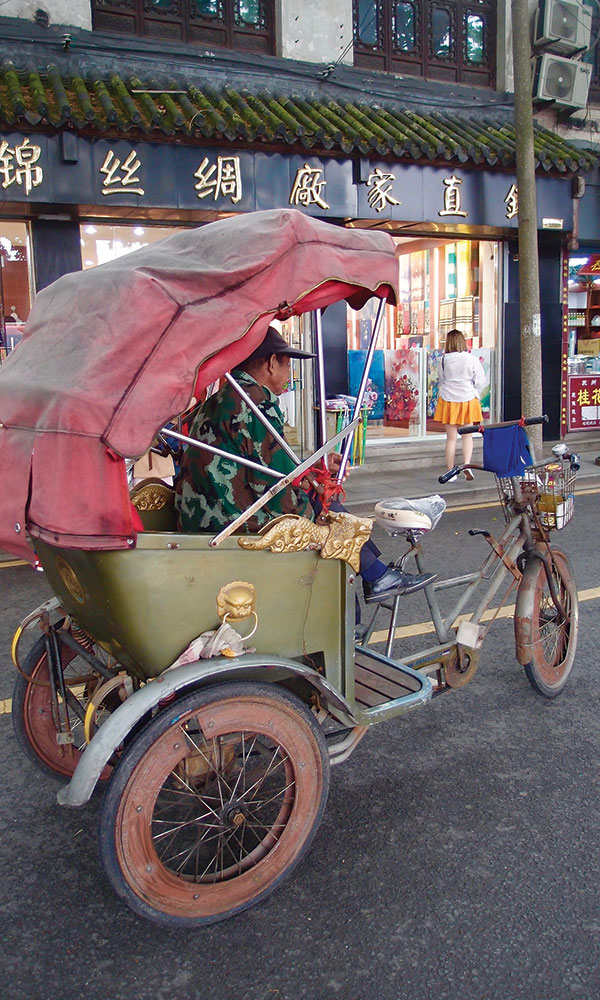
Yes, my travel bug started early. I was bitten sometime around my sixth birthday, when my parents gifted me what would become my favorite book, Around The World With Ant And Bee, an illustrated tale of best friends who travel to 11 countries searching for a lost umbrella. Over time, my travel affliction flourished, a side-effect of countless hours spent on the Disneyland “It’s A Small World” boat ride, transfixed by its kid-sized planet of 200-plus animatronic dolls in national garb, singing about world peace on an endless loop. Additional hardwiring of this global soundtrack came from my dad’s frequent, pitch-perfect renditions of Sinatra’s “Come Fly With Me” and Bobby Darin’s “Fabulous Places,” which, between the two songs, included a lyrical laundry list of 30 must-see exotic locales. Add to that images of my ahead-of-her-time mom packing for glamorous business trips in an era when most mothers stayed close to home, and my childhood takeaway was this: Go see the world. And for decades I have, with the last 12 or so months being one of my most fevered stretches ever, with bags never totally unpacked and all roads eventually leading to Suzhou.
Just a 30-minute ride from Shanghai via the high-speed “MagLev” (shorthand for “Magnetic Levitation” train), which blasts through the countryside at 230 mph, Suzhou is the beloved get-away spot for millions of over-revved Shanghainese and tourists from all over China. They step off the train and back in time for a day or two, to savor glimpses of the all-but-disappeared Old World—at least the bits that China’s enthusiastic development has, mercifully, managed not to pave over (yet). In Suzhou, the collective soul is stirred by ancient canals, cobblestone streets, stone bridges, centuries-old neighborhoods and, on the rural outskirts, acres of steeply terraced, green tea plantations marching up gentle slopes. But Suzhou’s main attractions are the nine ancient, classical gardens—horticultural masterpieces, all of them—which as a group establish the area’s UNESCO World Heritage site bona fides.
How Suzhou got—and stayed—so green is mostly a matter of location and very good luck, having begun its existence roughly 2500 years ago, as a well-positioned fishing village and trading post between the lower tail of the Yangtze River and the shores of Lake Tai, China’s third largest freshwater lake. A few hundred years later, with the addition of silk production and the development of a couture-level embroidery industry favored by Chinese royalty, Suzhou evolved into one of the most important and wealthiest “water town” ports along the Silk Road, complete with an extensive network of canals to keep all that progress moving forward.
All those mercantile riches attracted a well-heeled crowd of scholars, intellectuals and government administrators who enabled the arts, especially horticulture, to flourish, with many of the well-to-do locals competing to outdo one another with the beauty of their gardens. At its horticultural peak in the mid-1500s, it’s said that Suzhou was home to more than 200 private gardens, where upscale residents could get away from it all, behind high walls. Little did they know, 600 years later, their sanctuaries would continue to offer solace, only now to millions of everyday people, rather than just a select few.
All this is not to say that Suzhou is preserved in amber. Far from it. Though Marco Polo dubbed it the Venice Of The East, were he to stroll the streets of Suzhou today, he’d not only recognize some of the Old Town sights, but he’d also likely be taken aback by the bustling mega-city of six million people that’s sprung up around it and, at times, through it. As one of the fastest-growing, most prosperous cities in China, thanks in part to its government-mandated incarnation as a high-tech manufacturing hub, the new Suzhou is well-stocked with high-end restaurants, an emerging nightlife scene and lakeside luxury hotels, such as the sophisticated InterContinental Suzhou, the sparkly W Suzhou and the sleek, ultra-masculine Tonino Lamborghini. There’s a China-sized, Vegas-style, LED-light dancing waters extravaganza on weekend nights, plus the showpiece Suzhou Museum, designed by legendary I.M. Pei. There’s also the massive Suzhou Center, a mall that’s home to 600-plus shops, not to mention indoor ski slopes, a paintball emporium and an Olympic-sized skating rink. There’s even an indoor pony-riding school, should an upstart Saratogian be interested in taking a spin on a few small horses. Everything’s up to date in Suzhou City.
Neither a shopper nor a pony-rider, my mission in Suzhou was to absorb the legendary gardens and to let the town and the culture envelop me—to take my brain as far from home as my body was. The first step, and one that should be de rigueur for any traveler venturing beyond Shanghai, is to book a licensed guide, as language and ground logistics can be a challenge on the mainland. Though I rarely use them, this time I took the advice of mainland friends and put myself in the hands of an extraordinarily competent, capable and unfailingly cheerful guide, Cathie, from the aptly named Suzhou MoreFunAsia Travel Company, who picked me up at the airport, whisked me to Suzhou and skillfully piloted me through her hometown’s highlights. In just three days, she enabled me to see—and comprehend—what, in my jet-lagged haze, would have taken me weeks (or possibly months) to navigate on my own.
On day one, Cathie said, “The Chinese, we build gardens. Westerners, they plant gardens,” reminding me that instead of European-style, mathematically laid-out rows of flowers and shrubs, I’d be looking at something far more complex: the horticultural application of Confucian and Taoist principles; yin and yang; balance and harmony—a make-believe, garden-sized world shaped, trimmed and arranged to replicate the beauty of the natural one. (No, Toto, we’re not in Saratoga Springs anymore.)
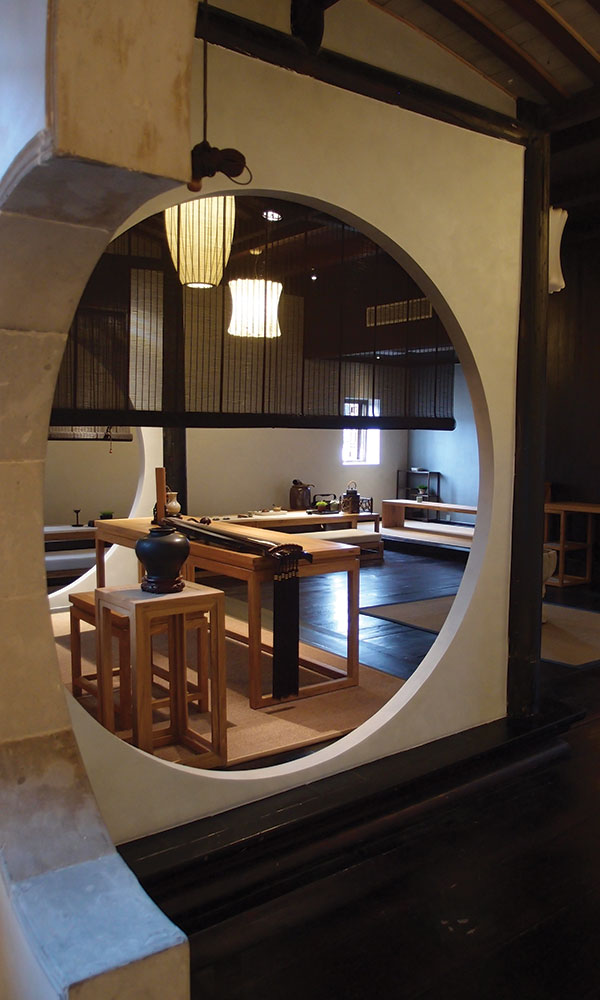
With all this in mind, we wandered the grounds of Tiger Hill, the final stop for the ancient ruler, warrior and sword aficionado King Helü, who died in battle in 496 BC. The story goes that at the bidding of his son, the king, along with his favorite 3000 swords, was buried within the 49-acre park. Under the guise of thanking the 1000 craftsmen who built the place, the son invited them to a banquet and fatally dispatched every last one of them, presumably before dessert, to ensure that the king’s exact burial location remained a secret. It worked. Erasure of the craftsmen notwithstanding, Tiger Hill is today a peaceful oasis that takes you on a trip through the greatest hits of classical Chinese landscape garden design. There’s lush yet manicured foliage, winding stone paths to stroll upon, carved-by-nature rock sculptures that look like miniature Matterhorns, delicate waterfalls and slowly flowing canals. Birds chirped and trees rustled as we roamed through this misty landscape that felt miles away from the bustling metropolis a few hundred yards beyond the garden gates. Giddy with jet lag and slightly intoxicated by the tranquility all around me, I offered a silent word of thanks to the murdered craftsmen who created it.
On the lawn below the park’s whitewashed Wanjing Villa, I watched master gardeners silently hand-trim bonsai trees, moving like a platoon of slow-motion Edward Scissorhands clones in green tracksuits and conical bamboo hats. When asked about his work among the 400 shrubs, one gardener replied that he liked the quiet, contemplative life of bonsai-tending. Sensing perhaps that it was time for me to stop intruding upon that life, Cathie sweetly prodded me onward with a gentle sweep of her arm and an endearing, “Dear Friend, there is much more to see.”
To escape the crowds on the way up to the park’s main event—the 154-foot-tall Huqiu Tower atop Tiger Hill—Cathie guided me up the much less traveled, back-of-the-hill path, past small, secluded tea fields tucked inside an otherworldly bamboo forest that called to mind the aerial sword fight scene from Crouching Tiger, Hidden Dragon—and for a moment, I wished that I, like Michelle Yeoh, could swing across the thick, leafy green treetops. Instead, we descended Tiger Hill on foot, back down to meet our driver, and, with a haggling assist from Cathie, I was able to purchase an enormous hand-fan adorned with a portrait of Chairman Mao, which now resides on the mantelpiece in my Manhattan apartment.
In the morning, we headed out early to beat the crowds. “Life is sweet in Suzhou. We have no flooding, no tsunami, no volcano. It is very peaceful,” Cathie said, as doors opened at The Humble Administrator’s Garden and we bypassed the already substantial queue. (Clearly, she’s got the hook-up.) As advertised, the garden is indeed a stunning masterpiece of the classical genre that’s not to be missed—and clearly, nobody in this part of the world does. Inside, the vast grounds are dotted with knolls and small streams. There are one-room pavilions with black tile roofs tucked between clutches of trees, shrubbery and rockery. Water is molded into thoughtfully arranged ponds filled with foot-long koi and lily pads the size of truck tires. Pavilion walls are pierced by artfully placed “moon gate” passageways and glass-less windows framing painterly views of the garden’s heavily curated natural world, a live version of traditional, painted Chinese landscapes. Suddenly, all those endearingly kitschy paintings lining the walls of virtually every stateside Chinese restaurant seemed kitschy no more, but rather lovely depictions of the memorable places that speak to the Chinese soul—and now, mine too.
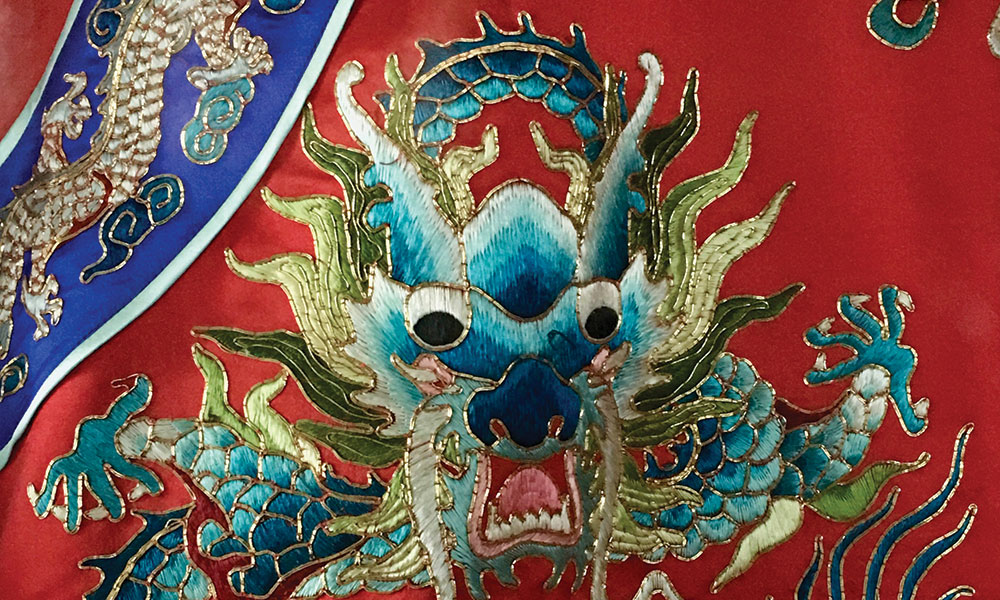
As the crowd swelled to more than 5000 within minutes of opening—according to the visitor-counting scoreboard stationed at the entrance—one did get the sense of how precious these gardens are to the Chinese psyche, and to the Chinese tourist. Though they’d likely never have the place to themselves—nor, for that matter, would I—it was still where we all came to slake our shared thirst for contemplative places, even if the solitude lay mostly in our imagination.
“Or, did it?” I wondered, when we arrived at the walled city gates of Tongli, walking its thousand-year-old cobblestone and canal-lined streets. Here, in this lovingly preserved, government-sanctioned, still-lived-in water town on the outskirts of Suzhou, if it weren’t for the cafés and shops occupying the town square’s storefronts, you’d be hard-pressed not to think you’d landed in a bustling, 16th-century Chinese village. Which is, of course, the idea. In Tongli, arguably, the main attraction, aside from the requisite ride along the tree-lined canals in antique, flat-bottom, oar-powered boats, and live Chinese opera being sung at top volume in the town square, is The Retreat & Reflection Garden. Also referred to as The Garden Floating On Water, one of the smaller gems in the UNESCO crown, it’s densely packed with a series of modestly sized, two-story houses and small pavilions connected by covered walkways, moon gates overlooking lush mini landscapes and bonsai trees in stone pots. The space brought to mind memories of actress Gong Li wandering the beautiful but claustrophobic grounds of her adopted home in Raise The Red Lantern. The structures here, though, were anything but ominous, having been artfully arranged to ensure beautiful views and visual surprises at every turn, despite the spatial constraints. At the center lay the garden’s main courtyard, surrounding a large, shoreless pond, creating a sort of optical illusion that made the buildings throughout the complex appear to magically float on the water, for an ethereal effect.
From The Retreat & Reflection Garden, we turned down one of Tongli’s born-for-Instagram, shoulder-width-wide walkways. At alley’s end, hidden inside an ancient structure, a stylish surprise awaited: the elegant, ultra-modern, reservation-only, 14-seat vegetarian restaurant Xishantang, whose delicate dishes elevate plant-based cuisine—and streamlined Taoist interior design—to high art. Though we were just a block away from the more typical tourist-friendly, open-air eateries that overlooked the canals, aesthetically, we were light-years away and loving it. After lunch, our Xishantang hostess (the chef’s sister) led us through another labyrinthine alley to an affiliated property, the small but exquisite Taimuting Hotel, a luxurious, Japanese ryokan-style, eight-suite guesthouse, just opened after a nine-year gut renovation by a Suzhou-born architect. It was all I could do not to ditch Cathie for a few days and sleep off my jet lag in this architectural jewel box, but such a move might have been frowned upon, even by my most accommodating Dear Friend. I realized I’d fallen hard for the sweetly cinematic Tongli and the charms of old Suzhou, and I will definitely plan to see them again someday.
Here are seven additional must-do’s in Suzhou besides all of those wonderful gardens:
1. Stay at the sophisticated and spacious Intercontinental; a highlight is its large, Michael Phelps-worthy indoor swimming pool.
2. View the aforementioned LED Dancing Waters, crowd-free, from the roof deck cocktail lounge atop the W Suzhou.
3. Spend a few hours window-shopping Suzhou’s not-to-be-missed 1000-plus wedding dress storefronts, packed with every type of gown imaginable, from RuPaul-style sequin show-stoppers to sleek Angelina Jolie-ready styles and everything in between.
4. Take in the “Master of Nets” show (at Master-of-Nets Garden, of course), a gorgeous progressive performance, where the audience moves from one part of the garden compound to the next to experience a series of five-minute-long song, dance, musical and spoken word performances.
5. Test your skills against the incredibly skilled embroiderers at the Silk Museum.
6. Try your hand at a Chinese calligraphy lesson with a local master.
7. Ride a bicycle rickshaw for the best way to tour Suzhou’s quiet back streets (see bicycle photo above).
Shanghai
Bidding à bientôt to Suzhou, I was off for a quick once-around in Shanghai, China’s go-go-go, money-mad capital on the banks of the Huangpu River. Though I’m drawn more to Hong Kong’s tropical-isle-meets-high-rise aesthetic, when gazing out the window of the JW Marriott Hotel Shanghai’s 59th floor cocktail lounge, it was hard not to be gobsmacked by the power of Shanghai’s Fritz Lang-ian Metropolis-style skyline—arguably the world’s largest—fanning out for miles, far beyond the viewable horizon. As night started to fall and fog began to obscure the tops of the skyscrapers that surrounded me, I half expected the rain-soaked cast of Blade Runner to roll in for a nightcap.
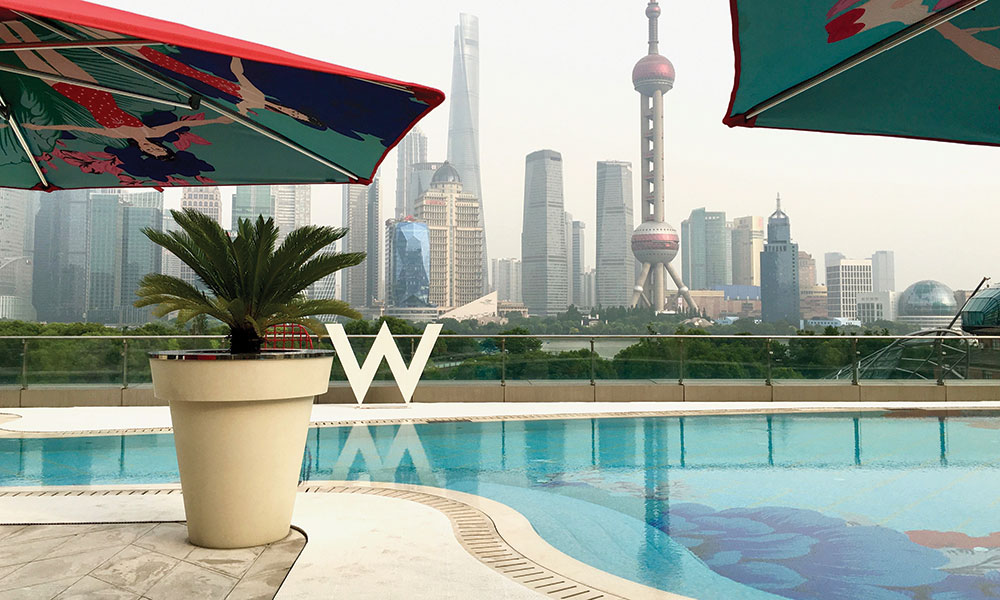
At sunrise, my goal was to find what remained of Old Shanghai, which, tough as it may be to locate now, will be all but impossible to find in a few short years, as it’s scheduled to disappear by 2020. And so, the Four Seasons Puxi, my home for the duration, arranged a private visit to one of the last remaining “shikumen” compounds, the gated, village-like enclaves of 19th-century stone houses that once covered much of Shanghai. Now on the inevitable bulldozing block, due, in part, to its stellar location in the middle of Downtown’s most valuable real estate, the (almost) sole shikumen-style survivor compound to which I was headed, just off Wei Hai Road, was a photographer’s dream, though probably not much fun to live in (think communal kitchens and toilets, and tiny living quarters). So it was only fitting that the person who led me through the Old-World maze was the godfather of contemporary, post-Cultural Revolution Chinese photography, Gang Feng Wang, hailed as China’s very first freelance photographer. Coincidentally, it was Wang’s striking documentary-style photos and time-lapse videos of Shanghai that caught my eye months earlier when I was Googling the city. As far as I was concerned, I was in the presence of a local celebrity, one who’d grown up here, had kept a studio here for decades and was greeted warmly by almost everyone we met.
Overhead, laundry and electrical lines formed beautifully chaotic canopies as we climbed up creaky stairways, across renovation-ready rooftops and around under-the-radar mahjong games. We were waved into overstuffed apartments by house-proud residents and wandered through shared hallways packed with bikes, extra furniture, pots, pans and the occasional grandma skillfully peeling vegetables. I spent much of my time jogging, squatting and dropping to one knee, doing my clunkier version of David Bailey in Blow-Up, shooting rapid-fire snaps of every corner, every doorway, every stone in the street. After watching about two hours of my enthusiastic if somewhat ungainly performance, Wang, a quiet and observant soul, noted with a wry smile, “You have an eye for this place. I can see you understand.” High praise from the master, and I beamed with pride.
Hong Kong
A few weeks and I’m off (again) on Cathay Pacific, as the dusk crept in over Victoria Harbor, and misty low clouds were making the buildings on both sides of Hong Kong glow in blue-gray sepia. Traffic lights cycled through their tri-color routines, as red aviation lights blinked in their own rhythm atop sky-high rooftops of the city’s tall, thin office and apartment buildings. I was sipping a glass of Ruinart champagne, staring at the never-ending water ballet in the harbor below, with hundreds of styles of boats zipping back and forth like a swarm of aquatic hummingbirds. From the executive lounge on the 45th floor of the Four Seasons Hong Kong—a bucket-list hotel if there ever was one—I could have watched this dance all night, and had done so on many previous trips.
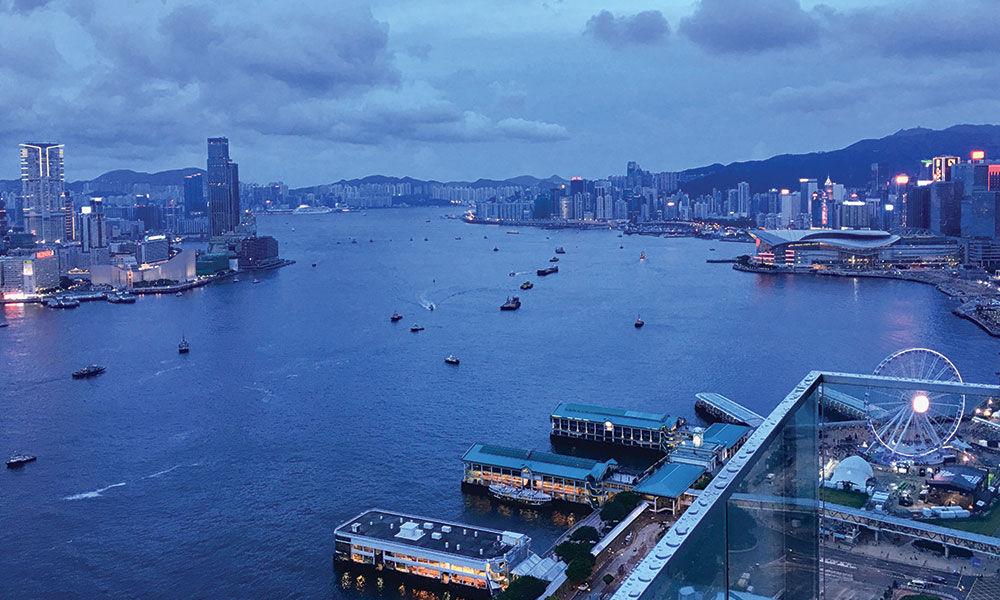
This time, however, I was here for a few meetings, so sleep was definitely on the menu. I’d also be celebrating a milestone anniversary with my husband, who’d just arrived to hike the mountains around Hong Kong (in 98-degree heat) on a magazine assignment. We were both here to work, then relax a bit in this place so luxurious it was akin to living inside a cashmere cloud, where life was soft, serene and seamless. Step outside the cloud though, and reality hit you like a hot, wet blanket. Not getting doused in sweat within seconds of stepping out onto the narrow, breezy, 45th-floor balcony was an impossibility—and we rushed back into cooler climes. We clinked glasses and tucked into the copious, lounge-supper spread we’d be sharing only with one American family of five in the corner and, one table away, our Asian doppelgängers (or were we theirs?) who were matching us small plate for small plate, cocktail for cocktail. Though their look was decidedly Architect-Navy-Blue-chic and ours more New Yorkers-in-all-black, it was evident that, on some telepathic level, we seemed to know one another well. Perhaps they were celebrating an anniversary, too?
With bellies full and our mood effervescent, we teetered down to our 24th-floor room, with its enormous bed, water-facing, cozy chaise lounge and panoramic floor-to-ceiling windows. But something was off. It was just 8pm on a Saturday night but, uncharacteristically, one of the busiest harbors in the world was suddenly eerily devoid of activity. I switched the room lights off to get a better look, but all I could make out below was the outline of darkened boats hanging back, lurking in the distance. Slightly unnerved, I grabbed my camera, pointed it toward the water, and then, the sky exploded! Rockets streaked hundreds of feet up into the sky, then burst into red stars, sparkling green bouquets, glowing white orbs, purple flowers and orange streamers, then dropped into the water, again and again—a full 23 minutes of nonstop, beautifully choreographed fireworks thundering past our window. Wow. Welcome to Hong Kong, and happy anniversary to you, too. Turns out we’d arrived just in time for the official “Fireworks Display To Celebrate The 20th Anniversary Of The Establishment Of The Hong Kong Special Administrative Region” event, or, in plain English, the end-of-British-rule, hand-over memorial, a bittersweet moment for some, a joyous occasion for others, but an unforgettable extravaganza for all.
For the second part of Hooper’s adventure, click here.


